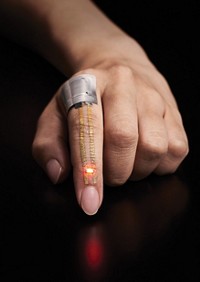Advertisement
Grab your lab coat. Let's get started
Welcome!
Welcome!
Create an account below to get 6 C&EN articles per month, receive newsletters and more - all free.
It seems this is your first time logging in online. Please enter the following information to continue.
As an ACS member you automatically get access to this site. All we need is few more details to create your reading experience.
Not you? Sign in with a different account.
Not you? Sign in with a different account.
ERROR 1
ERROR 1
ERROR 2
ERROR 2
ERROR 2
ERROR 2
ERROR 2
Password and Confirm password must match.
If you have an ACS member number, please enter it here so we can link this account to your membership. (optional)
ERROR 2
ACS values your privacy. By submitting your information, you are gaining access to C&EN and subscribing to our weekly newsletter. We use the information you provide to make your reading experience better, and we will never sell your data to third party members.
Analytical Chemistry
Newscripts
Two fashion debuts: The Little Black Graphene Dress and electronic devices to keep skin looking young
by Marc S. Reisch
February 20, 2017
| A version of this story appeared in
Volume 95, Issue 8
Graphene enters the fashion fray

Several years ago, graphene was all the rage among geeks. But now fashionistas are getting in on the action with the debut of the Little Black Graphene Dress. The dress is designed by haute couture champion Cute Circuit, whose clients include singers Katy Perry and Nicole Scherzinger.
Graphene is merely an atom thick, but it is nevertheless prized for being a strong, lightweight, electrically conductive material. University of Manchester professors Kostya Novoselov and Andre Geim discovered graphene and received the Nobel Prize in Physics for their work in 2010.
Scientists are developing the promising material for use in semiconductors, wearable sensors, batteries, and composite materials. Experts at the University of Manchester say that someday people will be able to buy graphene-enabled smartphones that they can wear on their wrists or graphene-enhanced electronic tablets that they can roll up like a newspaper.
But the world of fashion had eluded graphene until British shopping mall operator intu brought the university’s National Graphene Centre together with Cute Circuit. Their collaboration finally links graphene scientific savvy with fashion logic.
The dress features a graphene waistband that senses the wearer’s every breath and powers small light-emitting diodes embedded in the dress. The LEDs, including one embedded in a translucent, graphene-coated conductive panel, flash and change colors depending on the wearer’s breathing rate.
The Graphene Centre says the fashion-forward Little Black Graphene Dress of today anticipates the graphene-enhanced garment of tomorrow. One day, the institution suggests, an app controlling the highly conductive transparent material could be used to flash eye-popping digital patterns across a garment. And wearers could also use the app to change a garment’s colors based on their whims.
How to flash skin for a healthy glow

Flashes of a different sort could needle the synapses of folks who want to keep their skin looking young, should electronics maker Samsung bring another futuristic electronic concept, S-Skin, to market.
Stepping onto the stage at the Consumer Electronics Show in Las Vegas last month, S-Skin aspires to be a personal dermatologist for blemish sufferers. It’s a must-have device for a person whose skin breaks out even though he or she may “carefully” take care of it, Samsung says.
S-Skin uses colored LEDs to correct skin problems. For skin that needs a little extra nudge, associated microneedle patches are available to do the heavy lifting and firming.
The brainchild of Samsung’s C-Lab, a start-up business unit that encourages creative new ideas, S-Skin starts working its magic when the user deploys sensors on the device to detect skin moisture, melanin levels, and those dreaded red spots.
An app on a user’s smartphone interprets the readings and, depending on the seriousness of the situation, recommends the LED protocol or a patch option. Unlike the flashing graphene dress, the LEDs on the S-Skin device aren’t just for show.
Samsung says that different colored LEDs treat wrinkles, firm and lift saggy skin, and lighten skin, depending on how far gone the app considers the user’s skin. Users who have skin that requires more heroic measures can apply under-the-eye and spot patches that dispense antiaging ingredients through biodegradable microneedles.
But what if a user’s skin doesn’t break out? Samsung’s alternative Lumini device captures an image of its subject and then deploys algorithms to reveal lurking blemishes in an associated smartphone app.
Users need not fear the new truths brought to light: The Lumini app will also connect the user to a friendly dermatologist who can recommend remedies to imperfections before they expose themselves. So everyone can dress in the latest graphene fashions and always be assured of looking their best.
Marc Reisch wrote this week’s column. Please send comments and suggestions to newscripts@acs.org.





Join the conversation
Contact the reporter
Submit a Letter to the Editor for publication
Engage with us on Twitter